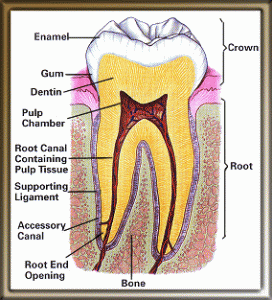
Tooth structure
Broken Teeth and Fractured Teeth Overview
Our teeth are very strong. We have an outer layer of enamel covering which can only be sectioned or cut with diamond coated drills. However, over the years due to hard diets or decay of tooth, the tooth structure of enamel becomes weakened. That is when our tooth can chip and have a fractured tooth (cracked tooth) and also a broken tooth.
Symptoms of Broken Teeth and Fractured Teeth
Symptoms of Broken Teeth
Most of the time when patient experience broken teeth , they will feel like their teeth is sharper or it has changed in shape and become smaller in size. A broken front tooth is easy to spot and see as people usually have easy visual excess to that area. If the broken teeth does not involve the nerve part of the tooth (the pulp chamber), then the patient will feel no pain at that tooth. However if the broken teeth involve the nerve part of the tooth, pain or sensitivity will be felt on chewing or during any temperature change.
Symptoms of Fractured Teeth
Symptoms vary from case to case depending on the extent and type of fractured teeth:
- Craze line (minor fracture) . The fracture is only confined to the enamel layer-This condition usually has no symptoms.
- Fractured cusp. There is a fracture on the crown and upper part of the root of the fractured tooth-Patients usually feel a sharp pain or zaps on chewing or taking hot or cold drinks.
- Split tooth. Tooth is fractured right down the middle-Patient usually feels pain on chewing, however sometimes it is painless as the nerve of the tooth might have died.
- Vertical tooth fracture. Fracture on the root portion of the tooth-Pain might come and go on chewing or while doing nothing.
Treatment of Broken Teeth and Fractured Teeth
Broken Tooth Treatment
All broken teeth should be treated by a dentist. Sometimes during trauma , only a part of the tooth will break, sometimes even the whole tooth breaks out of the tooth socket.
Immediate treatment would be to pick up the broken part of the tooth or the whole tooth which has fallen out and keep it in milk solution or your own saliva. See a dentist immediately preferably within an hour.
At the dentist, the dentist will examine to see if the nerve of the tooth is involved. If it is involved, the option would be to do a root canal filling and a crown will be constructed. If it only involves the outer part of the tooth (enamel or dentine), a broken tooth repair with a filling or a restoration will be done to restore the tooth structure. If there is an old broken tooth filling, it has to be first removed and then replaced with a new one. Tooth structure which has broken off can also be cemented back into place. If the broken tooth is too severely broken and can no longer be saved, the quickest and only option will be to go for a broken tooth extraction.
Fractured Teeth Treatment
Treatment for fractured teeth again depends on the type of fracture. If the fracture is symptomless, the treatment would be to leave it alone. If however the fracture only involves the crown (upper part of the tooth above the gum’s ) and it is painful, a root canal treatment can be considered. If the fracture involves the whole length of the tooth including the root, splitting of the tooth can be done followed by a root canal treatment. When all else fails, the final option to relieve the symptoms would be to go for a tooth extraction.
Causes of Broken Teeth and Fractured Teeth
- Biting down on hard food.
- Fights or altercations.
- Decay of tooth.
- Contact sports.
- Motor vehicle accidents.
- Motor vehicle collisions.
- Falling and hitting the face.
Diagnosis and Test Of Broken Teeth and Fractured Teeth
- The dentist will usually use a visual diagnosis with a probe and mouth mirror. Most of the time fractured teeth and broken teeth are detectable if it only involves the crown of the tooth.
- Trans illumination method with a very bright light is also shone onto the suspected tooth. Any fractured or breaks will produce a visible shadow.
- The suspected tooth is also tapped or percussed with the back of the probe to test for pain. If no pain is felt a vitality test is done to see if the nerve of the tooth is still alive.
- A staining method can also be used to see if the dye seeps into the fracture lines.
Prognosis of Broken Teeth and Cracked Teeth
- Prognosis depends on the type of fractures or cracks.
- The tooth can usually be saved if it does not involve any nerve damage and there is enough tooth structure left.
When to contact a doctor
- Tooth falls out or bleeds after a trauma.
- Pain on chewing and drinking hot or cold drinks.
- Feeling of any sharp teeth in the mouth.
- The tooth is loose.
- Unable to bite or close the teeth properly.
Pingback: What Dental Corrective Surgery Could Do For You Part 1 | Intelligent Dental
Pingback: All about tooth sensitivity: Part 1 | Intelligent Dental
Pingback: What are Dental Crowns ? | Intelligent Dental
Good point. I hadn’t thought about it quite that way. 🙂